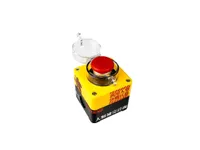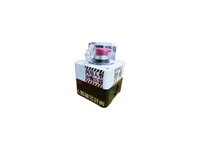Atomic nuclear bomb launch button lets you power your PC on or off — Evangelion-themed wireless power button is cool and convenient

Are you sick of powering on or shutting down your system with the boring button on your case? How about using an atomic nuclear bomb launch button like those that you see in the movies? Newegg is currently selling an Evangelion-themed power button for $22.49. Whether you're an Evangelion fan or not, you can't deny there's no cooler way to power on or off your system than slamming a big red button.
Hailing from Corn Electronics, the Evangelion power button communicates with your system wirelessly, so there's no annoying cable going to your motherboard like those external power button alternatives on the market. Some wires are still involved, but they're all inside your system so that they won't mess up the harmony on your desk.
The standard version has a yellow and black exterior, while the alternate version features a white and copper theme. Either way, you must lift the plastic cover and hit the big red button to use its functions. The white version is slightly cheaper at $14.59.
Evangelion EVA Wireless Power Button: now $22.49 at Newegg (was $24.99)
Evangelion-themed wireless power button for desktop systems.
Evangelion EVA Wireless Power Button: now $14.95 at Newegg
Evangelion-themed wireless power button for desktop systems.
The only downside is that the Evangelion power button requires a small add-in card that will fill up one of the PCIe expansion slots on your motherboard. It will be a turn-off for mini-ITX motherboard owners who typically only have access to one PCIe expansion slot and potentially for the microATX ones if they have many devices connected to their PCIe expansion slots. Luckily, it's a small PCIe x1 add-in card, measuring 39.3 x 37.25 mm, so it's not overly intrusive and demanding on bandwidth.
The add-in card is Xiaomi's Youpin Mijia boot card, which costs $16.22. The card typically pairs different Xiaomi devices, such as speakers, smart alarm clocks, lighting hubs, etc. It leverages an MHCB07 2.4 GHz Bluetooth Low Energy (BTLE) module, a popular choice for Xiaomi smart devices.
Three cables connect the add-in card to the motherboard. One goes directly to the motherboard's USB header, whereas the other two connect to the Power Switch of your front header and your case's power button.
The Evangelion power button connects to the add-in card via Bluetooth for a coverage of up to 30 meters. When first turned on, a blue LED will indicate that it needs to pair with the add-in card. Pushing the button on the side will pair it with the add-in card, and the light will turn off. The Evangelion power button recharges through a standard USB Type-C cable. However, the manufacturer didn't specify the button's battery capacity, the estimated usage time before requiring a recharge, or how long it takes to charge it completely.
Get Tom's Hardware's best news and in-depth reviews, straight to your inbox.

Zhiye Liu is a news editor, memory reviewer, and SSD tester at Tom’s Hardware. Although he loves everything that’s hardware, he has a soft spot for CPUs, GPUs, and RAM.
-
Sleepy_Hollowed I don't know how to feel about a wireless power button.Reply
The concept is great though, especially if you live in a place where no one can get within wireless range. It would suck for those that use a dedicated sound card and a graphics card, though that's a very small number of people. -
DRagor Replysmall PCIe x1 add-in card, measuring 39.3 x 37.25 cm
I suppose it should be mm, not cm? Because forty cm card would be bigger then most motherboards. -
Alvar "Miles" Udell ReplyLuckily, it's a small PCIe x1 add-in card, measuring 39.3 x 37.25 cm, so it's not overly intrusive and demanding on bandwidth.
The problem comes in where motherboards with only 2 PCIe slots (such as mATX boards) can only operate at x8/x8, or full ATX boards where the third and fourth PCIe slots are disabled if you use an NVMe drive, so this can indeed become quite intrusive and demanding on bandwidth. -
redgarl You are not buying this for practicality, you are buying it for all the rest. As a fan, of the series, I think I will grab one.Reply
It is nothing more than a conversation piece. I am not sure why, but Evangelion just got back on the map, it is as hot as it can be.
Anyway, my next built will be themed in consequence with Asuka. I guess you need to fill those stupid Aquarium they call PC cases nowadays... -
Blitz Hacker Tom's hardware. Omg .. look how much water this uses that's bad for the environment!Reply
Also Tom's: Hey look here's a big plastic button you don't need that offers no functionality what so ever. (Obviously enviro safe) It's 'cool':ROFLMAO: -
Mindstab Thrull Up until Windows 10 (and starting with Windows 98SE), I have two shortcuts on my computer to shut down or restart the computer - one for each. I also have my BIOS set up to put the computer in the last stage it was in when it gets power - if it was on when it last had power, start the computer up. So for someone like me, this is just a random piece of cool, but for a lot of people, it's a lot more convenient - and fun!Reply
(Incidentally, the shortcut doesn't seem to work with Windows 11, or maybe it just needs tweaking. Time to find out!)
Mindstab Thrull
Nomming ur sanities since 1867 BSE (before the Sarpadian Empires) -
PEnns How about igniting a fuse to a stick of dynamite... for us old fashioned folks??Reply
Or even this one....:cool:
-
Corwin65 Reply
This makes me want to see a falling anvil.PEnns said:How about igniting a fuse to a stick of dynamite... for us old fashioned folks??
Or even this one....
:cool:

